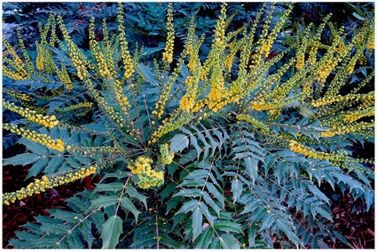by Bruce Bennett • With the great diversity of Northwest plants, it should not be surprising how similar some can look! This situation can work in your favor as one of those lookalikes may be a better plant for the growing conditions of that bare spot in your landscape. If you wind up doing some plant sleuthing of your own, make sure you keep in mind some of the imposters we are looking at in this issue. Plants may share similar visual characteristics in their leaves or flowers, but, there are ways to separate the lookalikes from the final candidate that will be gracing your planting borders.
An initial way to begin sorting and identifying shrubs is leaf placement. After looking at how the leaves attached to the branches of some competing hollies, it was easy to determine the correct plant. This first holly’s leaves were attached right next to each other (opposite) versus alternating growth on the stem and had dusty-blue clusters of fruit.
The Oregon Grape Holly (Mahonia aquifolium, recently changed to Berberis aquifolium) is not a holly, but, rather, our West Coast native. It has small yellow flowers in spring, has leaves attached right next to each other (opposite versus alternating growth) on the stem, has dusty-blue clusters of fruit, matures at about 2’-6’ depending on cultivar, and tends to attract mildew and other diseases when water stressed. Historically speaking, it is still the best garden plant that Lewis and Clark brought back to the early United States after their expedition thru the newly acquired Louisiana Territory ending on the Pacific coast. The most popular of these shrubs are known as Tall (M. aquifolium), Short (M. repens) and Creeping (M. nervosa) Mahonia.
English Holly (Ilex aquifolium) is a true holly, has alternately placed leaf attachments on the branches. It also had more spiny armament on its glossier leaf tips and had red berries. While having a more classic holly look and can be found in a variegated form, this holly tends to mature to a rather large 50’ x 25’, is invasive and outcompetes other PNW forest natives.
Let’s consider other holly-looking shrubs that have better appearances and may be a better fit for your evergreen landscapes and foundation plantings. Among my favorites are the American Holly, Holly Olive/False Holly (Osmanthus heterophyllus) and Mahonia (Mahonia x media).
American Holly (Ilex opaca) is considered one of the most popular trees in the world. There are currently more than 1,000 different cultivars. It’s known as the hardiest broad leaf evergreen, has been grown in -20°F areas, and will grow in nearly all soils. It has a slow to medium growth rate and, depending on the cultivar, can mature at size of 2’ x 3’ up to 40’ x 30’. Pick your plant and site wisely! Like all true hollies, the plant is dioecious meaning you will need a male plant within 40’ of your female plants if you want to enjoy the classic red berries and a flurry of feeding winter birds.
Variegated plants can help brighten shady areas of a bed. They are also good at breaking up a mass of green shrubs and adding needed year-round color contrast. My current favorite is Japanese False Holly ‘Goshiki’ (Osmanthus heterophyllus).
Osmanthus has leaves are opposite one another and have spines that are softer the holly. ‘Goshiki’ translates to “five colors” as the new leaves open maroon-red and turn green with spots of creamy white, gray-green and yellow-green. It adds a distinct, year-round look to the yard. Left to its own devices, Goshiki will grow to be a dense 6’ x 4’ shrub, but it takes kindly to pruning when it begins to show new growth spring.
Mahonia x media ‘Arthur Menzies’ (recently changed to Berberis x hortensis) Oregon Grape was once relegated to native and woodland gardens but has now become a mainstream garden plant for many good reasons. It is easy to grow and has bright winter flowers that provide food for hummingbirds and bees at a time when few other plants are blooming. Once established, most forms require little supplemental water.
Arthur Menzies is among the tallest of these Mahonia, growing up to 15’ tall and 10’ wide. One way to maximize the benefit of this and similar plants is to grow it at the back of borders so when the plants in front die back, the flowers and foliage of the mahonia are clear to see.
Once established, most hollies and lookalikes are very tolerant of being pruned. Wait to trim your hollies until they begin to show new growth in the spring. They will grow nicely in full sun to part shade and are not particular about soil. Try to provide a bit of afternoon protection from the sunlight.
Contributing garden columnist, Bruce Bennett, is a Washington State University Certified Master Gardener, public speaker and Seattle-area garden designer. If you have questions concerning this article, or have questions concerning your garden, contact Bruce at gardenguy4u@gmail.com.


